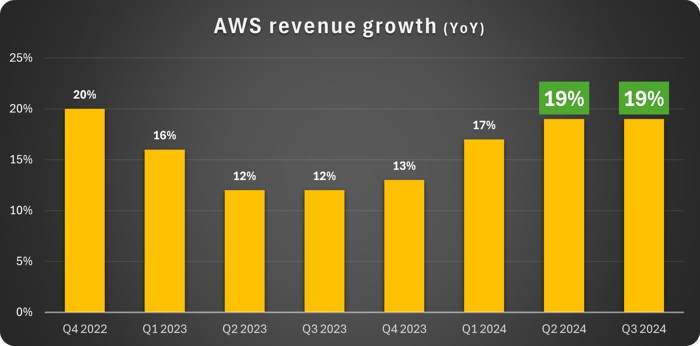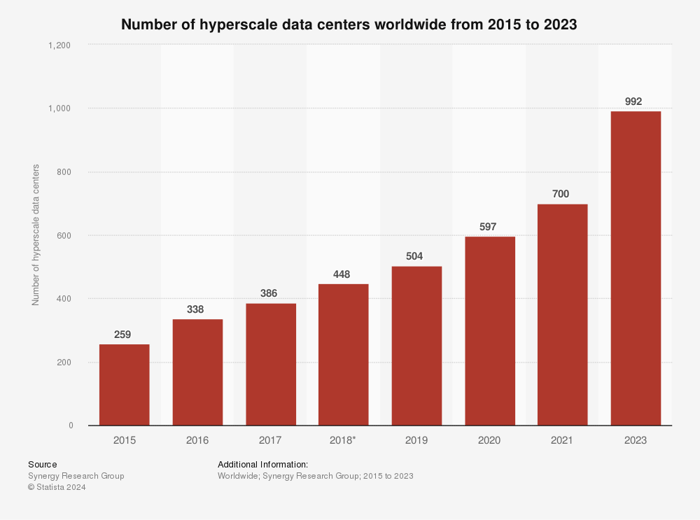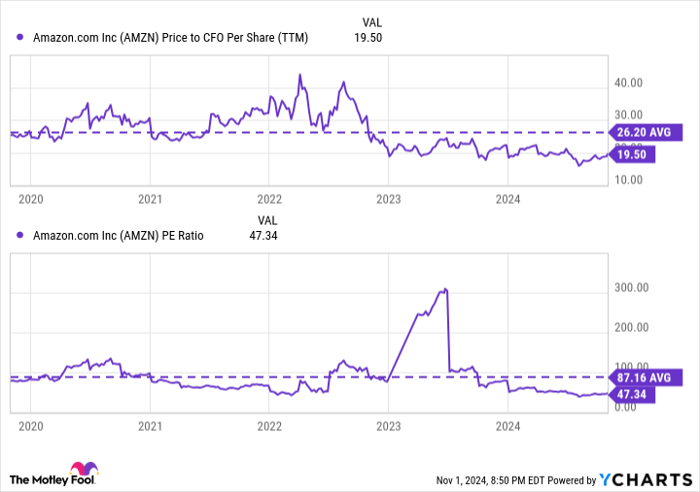Plenty of stock have ridden the boom in artificial intelligence (AI) this year. I’m going to focus on the two that make my buy list.
One aspect of AI software is the huge demand for data processing power, all of which has to be housed somewhere. This is driving demand for hyperscale data centers (those of more than 100,000 square feet), which are exploding in size and number. The chart below shows the recent acceleration.

The number passed 1,000 in 2024; researchers expect 120 to 130 to come online each year. Huge centers are being built by the tech giants. For instance, Elon Musk’s xAI data center will be 750,000 square feet and house 100,000 GPUs, while Microsoft’s data center coming to Wisconsin will cover two square miles of land.
Dell Technologies
Why is this important to a company like Dell Technologies (NYSE: DELL)? These centers need infrastructure, like racks, storage, servers, and software, which Dell provides.
Dell believes it has a $91 billion addressable market in AI infrastructure in 2025 that will balloon to $124 billion by 2027, and one of its largest competitors in the market, Super Micro Computer (NASDAQ: SMCI), is having troubles. Supermicro’s stock is down considerably after a short-seller released a detailed report alleging financial misdeeds and its auditor resigned, indicating potentially serious accounting problems. This could mean Dell will get more business while Supermicro deals with the fallout.
Driven by data centers, Dell’s servers and networking sales hit $7.7 billion last quarter on spectacular 80% year over year growth. Dell’s total sales last quarter hit $25 billion, up 9% year-over-year, and its operating income was up 15% to $1.3 billion. Dell’s PC sales have struggled as the economy slows and are little changed this fiscal year. However, Dell believes it could see an upgrade cycle driven by AI-ready computers, although this remains to be seen. Data center sales will likely be the most significant earnings driver from here on.
Investors who like dividends and stock buybacks will appreciate Dell’s operating strategy. The company commits to returning 80% of free cash flow to shareholders through these channels. The dividend was recently raised 20% to $0.445 per share quarterly for a 1.3% yield. The company also repurchased $1.4 billion in shares through the first two quarters of fiscal 2025 (ended Aug. 2). This is 1.6% of the current market cap repurchased in just six months.
Dell’s stock trades at a price-to-earnings ratio of 24; however, this drops to just 14 on a forward basis. Twenty-one of 24 analysts following the stock rate it a buy or strong buy with an average price target of $146, or 12% more than the current price. However, these targets could be low because they have not yet factored in the additional business that Dell will likely get due to the challenges facing Supermicro. The stock could rise swiftly if Dell surpasses analyst estimates in the coming quarters.
The market is (still) sleeping on Amazon
Amazon is deeply embedded in the AI race, notably through Amazon Web Services (AWS), Amazon Bedrock (read more on this here), and initiatives in AI chip development. AWS is a huge beneficiary of the gigantic data needs of AI software as it is the largest cloud data provider on the planet. Revenue in this segment jumped in the past two quarters after a lull in 2022, as you can see below.

Data source: Amazon. Chart by the author.
The 19% growth in Q3 caused AWS sales to reach $27.5 billion for the quarter. More telling was that the segment produced $10.4 billion in operation income for a wide 38% margin. The margin for the same quarter last year was 30%, which is clear evidence of increasing demand for cloud data services.
Amazon’s total income for Q3 grew 11% to $159 billion, and total operating income was $17.4 billion vs. $11.2 billion in the prior year. Amazon’s operating cash flow blew past stimulus-era peaks and shows no sign of slowing, as shown below.
AMZN Cash from Operations (TTM) data by YCharts
Yet, the stock is still undervalued historically, based on operating cash flow and earnings, as depicted below.
AMZN Price to CFO Per Share (TTM) data by YCharts
Wall Street may be cautious about Amazon because it anticipates a slowdown in consumer spending that would impact product sales; however, I believe the much more profitable AWS segment will fill any gaps in income. The historical undervaluation makes the stock a terrific long-term buy.
Don’t miss this second chance at a potentially lucrative opportunity
Ever feel like you missed the boat in buying the most successful stocks? Then you’ll want to hear this.
On rare occasions, our expert team of analysts issues a “Double Down” stock recommendation for companies that they think are about to pop. If you’re worried you’ve already missed your chance to invest, now is the best time to buy before it’s too late. And the numbers speak for themselves:
- Amazon: if you invested $1,000 when we doubled down in 2010, you’d have $22,469!*
- Apple: if you invested $1,000 when we doubled down in 2008, you’d have $42,271!*
- Netflix: if you invested $1,000 when we doubled down in 2004, you’d have $411,970!*
Right now, we’re issuing “Double Down” alerts for three incredible companies, and there may not be another chance like this anytime soon.
*Stock Advisor returns as of November 4, 2024
John Mackey, former CEO of Whole Foods Market, an Amazon subsidiary, is a member of The Motley Fool’s board of directors. Suzanne Frey, an executive at Alphabet, is a member of The Motley Fool’s board of directors. Bradley Guichard has positions in Amazon and Dell Technologies. The Motley Fool has positions in and recommends Alphabet, Amazon, Apple, Microsoft, and Nvidia. The Motley Fool recommends the following options: long January 2026 $395 calls on Microsoft and short January 2026 $405 calls on Microsoft. The Motley Fool has a disclosure policy.



